From 2015 to 2018, Ivan Chow made trips to and around Istanbul, Turkey, sketching many scenes along the way. In this excerpt from his upcoming book, “Travel Sketching: Drawing Insights from Istanbul,” he shares one of his favorite formats for drawing on location.
Travel Sketching: Tips for Keeping an Art Journal
BY IVAN CHOW
Travel sketching, an ancestor of sorts to Instagram, has changed the way I observe the world. I have discovered that the act and art of converting visual observation into graphic representation has far surpassed the benefits afforded by digital photography. What I have learned and enjoyed from the practice of travel sketching has enriched my travel experiences as well as deepened my appreciation of different cultures and peoples.
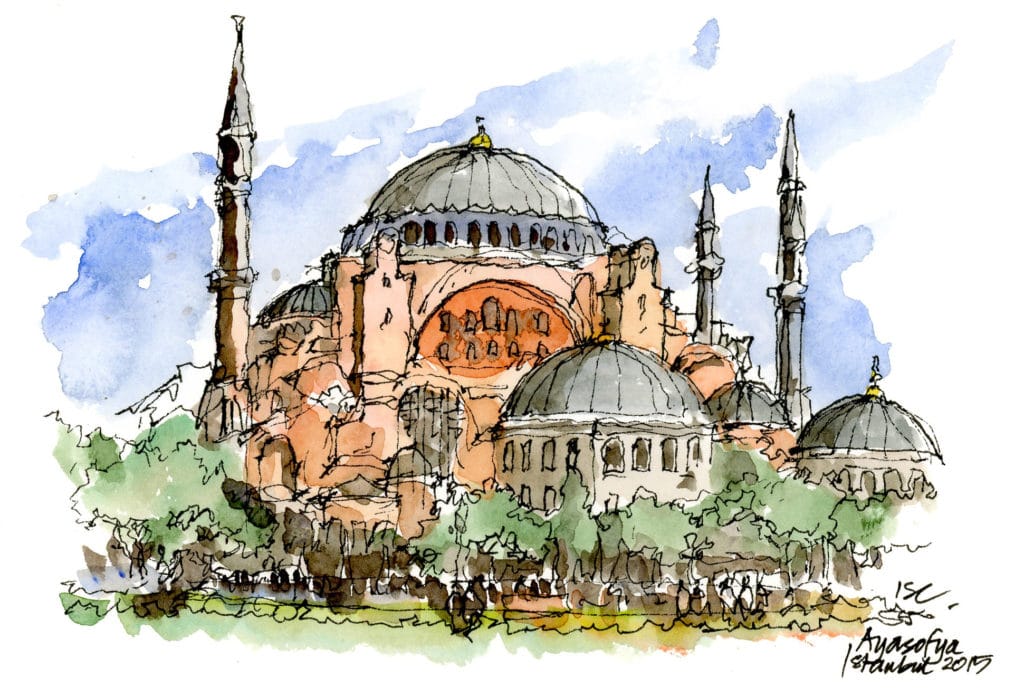
A Fresh Approach to Travel Sketching
One of the most invigorating formats for travel sketching is one I have recently become more intentional about, and which has been received with a great deal of enthusiasm, especially when posted on social media in audio-visual form. On platforms such as Facebook or Instagram, posts of travel photos depicting scenes or people accompanied by captions attempting to describe said experiences are fairly typical. Posting travel sketches, however, is still unique and arguably more interesting. Adding written captions or commentary makes this approach of sharing travel experiences even richer and more memorable.
Enter the travel art journal. While not necessarily a new genre or form of expression, it has become for me a fresh approach to sharing experiences in an otherwise digitally saturated world. A travel art journal has the potential to transform travel sketching into a unique mode of expression, combining drawing with handwriting and composition to create a new “voice.” My forays into developing art journal sequences have been thoroughly rewarding, as I can combine my drawing skills with an interest in writing to communicate much more than either discipline can on its own. That’s probably why comic books and graphic novels have such appeal and why skillful cartooning can be so influential.
A travel art journal can be formatted in as many ways as there are personalities. My favorite format is an A5 size journal (about 5.5” x 8.5”), either in landscape or portrait mode, with sufficiently thick paper to stand up to waterproof ink lines and light washes. (80 lb. minimum, 140 lb. preferred) As with sketchbooks, an elastic closure strap and inside back cover pocket can be helpful. In addition to the usual array of tools I might have on hand for travel sketching, I would add a few choice writing instruments, such as a chisel-nib calligraphy pen or fountain pen.
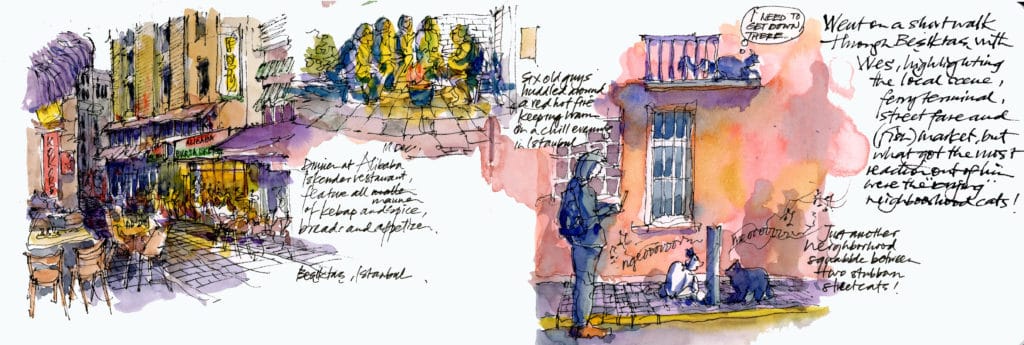
As the name implies, a journal is a regular log of activities and events that occur roughly in chronological order. A travel journal might memorialize the daily travel schedule, places visited, people met, cuisine enjoyed, and souvenirs acquired. A travel art journal adds the element of artwork in the form of sketches, doodles, graphic illustrations, even glued-on collages using torn excerpts from brochures, tickets, receipts, and labels. I have found this last exercise quite a satisfying way of closing out a busy day of touring.
Travel-art journal entries are unique compositional challenges. In its simplest form, each page might contain a few sketch vignettes describing the activities of the day. Arranging the sketches on the page may require some foresight, consideration of the size, scope, and subject of each vignette and how they might tell the story of the day. Each entry becomes a graphic design exercise involving the layout of sketches, diagrams, titles, and text.

The addition of handwritten text to a composition of sketches is both an enriching enhancement and a potentially stressful endeavor. It is enriching because it adds information, flavor, and specificity to a sketch. Potentially stressful because, unlike the editability afforded by computer software programs, each phrase or caption needs to be somewhat thought through and composed before being physically written within the space available.
I love to write by hand and am constantly experimenting with different writing instruments with different tips, nibs, and inks. It’s almost an obsession with me, and I am easily disappointed when my writing falters. Having said that, I highly enjoy narrow, flat-nosed calligraphy pens for travel art journaling, especially used in a generally cursive lettering style. However, most fountain pen type writing instruments with reservoirs have no tolerance for waterproof ink, which tends to clog the fins and feed tubes. This often leaves me with little choice but to use the waterproof ink felt-tipped pens I used to sketch with for lettering as well. A real calligraphic treat is to use Speedball dip nibs with bottled India ink, although both have proven not to travel well.

This summertime sketch of the renowned Taksim Square (above) was completed in one sitting but from multiple positions. I had begun sketching seated on the pavement in front of the Taksim Mosque facing the square. Within 10 minutes, the local constabulary approached, ordering me to move. I continued the sketch while standing about 50 feet to one side, which required walking to and from my original position for reference, and back to the “safe zone” to continue sketching, clutching my watercolor kit and sketchbook in one hand, pages flapping in the breeze; brush in the other hand, pinky finger trying to hold down the page.
I ended up crossing the street into the square proper and finishing the 45-minute sketch seated on a low rail around the Republic Monument. Even under these conditions, I was pleased by how the sketch reflected the windy conditions, the movement of people and the “life” of this symbolic gathering place.
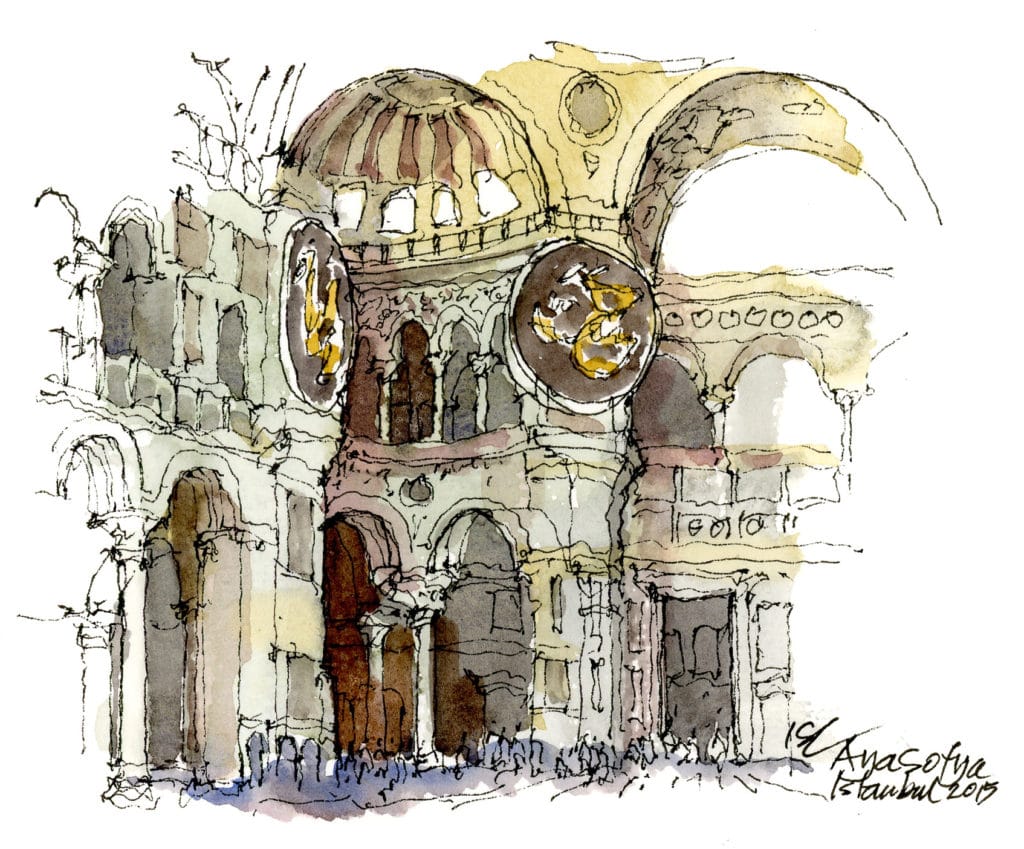
This interior sketch (above) was made while standing within the cavernous expanse of a 1,500 year-old Byzantine monument to Ottoman architecture and culture. The contrast from the warmth and bustle of the exterior to the hushed coolness of the inside almost mandated reverence.
This is where my Winsor & Newton professional watercolor travel kit came in handy, albeit restrictive. Being able to clutch both watercolor kit and sketchbook in one hand is a cultivated skill and immensely useful for situations like this. It was important to limit the scope of the sketches knowing that I would likely not be able to stand in place for much longer than 20 minutes at a time.

Do you keep a travel sketchbook or art journal? Tell us about it in the comments below!
ABOUT THE AUTHOR: Ivan Chow is an architect, author and award-winning artist. He was born in England, grew up in Southeast Asia, and has worked in the United States and around the world as an architect, educator and artist for almost four decades. He has practiced in design firms of various sizes; managed a private real estate company; worked in academia as a department chair and dean; and served as artist-in-residence at Frank Lloyd Wright’s Fallingwater. He has degrees in architecture from Harvard and Berkeley and a degree in theological studies from Gordon Conwell.
Facebook: @ivanchowsketches
Instagram @qkkdraw
> Click here to subscribe to the free newsletter, Plein Air Today
> And click here to subscribe to PleinAir Magazine so you never miss an issue!

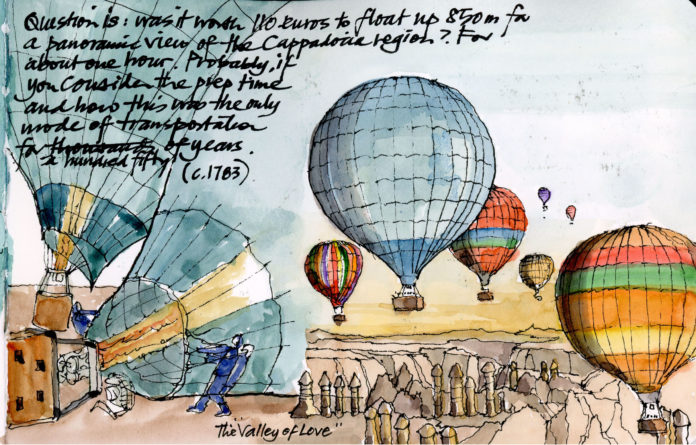
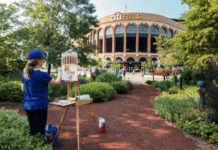


Your lines are lovely! I carry a 6×8 WC book and fine line pens as well as a travel WC set. A film can (remember those?) half filled with water is all I need to complete hasty or slow drawings and paintings wherever I go. In a ziplock, it fits under a car seat or in an airplane carryon. The water is small enough to pass security. Thanks for posting your images. I consider my pages suitable to be Urbansketches.
Hello Kath, please excuse my 5-month tardiness in replying, but I very much appreciate your comment. I still have a couple of film cans around! Have you tried posting on Instagram? (I am @qkkdraw) I learn so much from following other artists around the world.
I love travel sketching! I use the same size book you do, and I’ve found Lamy Safari sketching fountain pens to work wonderfully with waterproof ink. I have a small (Altoids tin) travel palette, and often use a water brush to add a little paint to a small ink sketch.
Leslie, I’m only now realizing there were comments to this September 2020 article! Sorry about the delay in response. The Altoids tine palette is such a good idea. Although I have a handful of water brushes, I tend to get annoyed and how the colors get muddles when I forget to rinse properly.
I have 2 types of travel journals. The first is done strictly with sepia Micron Pigma pens in a Moleskine journal. I do line drawings on the spot, or later in my hotel room from photos on my phone. I annotate the day with text. These pages allow me to look back and remember details of my trip. The second book is done strictly with watercolor. I use a Moleskine or HandBook watercolor journal. These paintings are always done plein air and without text. I love keeping travel journals and they have become treasured keepsakes.
Hi Marian, thanks for your comment; my response is unforgivably tardy, but hopefully still relevant. Interesting idea to keep two travel journals concurrent; I never thought of doing that. Makes sense though – almost like mood-based entries. I’ll try that on my next trip, assuming Covid gets dampened(!)
I started travel journal sketching on a 3 week trip through England. London, to western most area near Penzance and with to the Lizard. Then up to Bath, followed by a week in the Lake District. Now, I take it whenever we travel — though there’s been damn little of that lately!
KL, sorry about this delayed response. I really miss traveling; we used to make any excuse to visit our family all around the US and internationally but now stuck looking at the world through a laptop… I spent some time in the Lake District decades ago, before I took up travel sketching, and aim to go back some day armed with my weapons of art!
I have notebooks that I kept while serving in Germany where I sketched various church steeples as I took various bus tours. Every two weeks tours after joining reserves, I sketched and took photos
Hi Dixie. Thanks for sharing and please excuse my tardy response. Have you posted your steeple sketches on FB or IG! I learn so much from following what other urban sketchers are doing.
Ivan thanks for sharing the details. I have several different sketch books but need to start using one and go through it day by day . I usually try to sit down so I can put my watercolor pallet on the ground and bring a spritz bottle to keep them wet.
Hi Bruce, thanks for your response; there are no excuses for my super tardy one. The thing about these plein air experiences is that every one seems to be accompanied by lasting memories: the sounds, smells, hapticity of the moment. And the need to come up with inventive ways of setting the right ambience for each little sketch can be such an annoying yet rewarding travel experience.
Hi Ivan, great sketches and tips. I’ve kept illustrated travelogues and journals for a few decades now. Smaller sizes work best for me. It keeps the sketching from being too detailed, they are quick and leave just enough space for minor remarks. They are also discrete cause I don’t like to make a show. Check out my IG-feed @ivanseymus or visit my portfolio on http://www.ivanseymus.com.
Good luck and take care!
Ivan (yes, that’s my name too!)